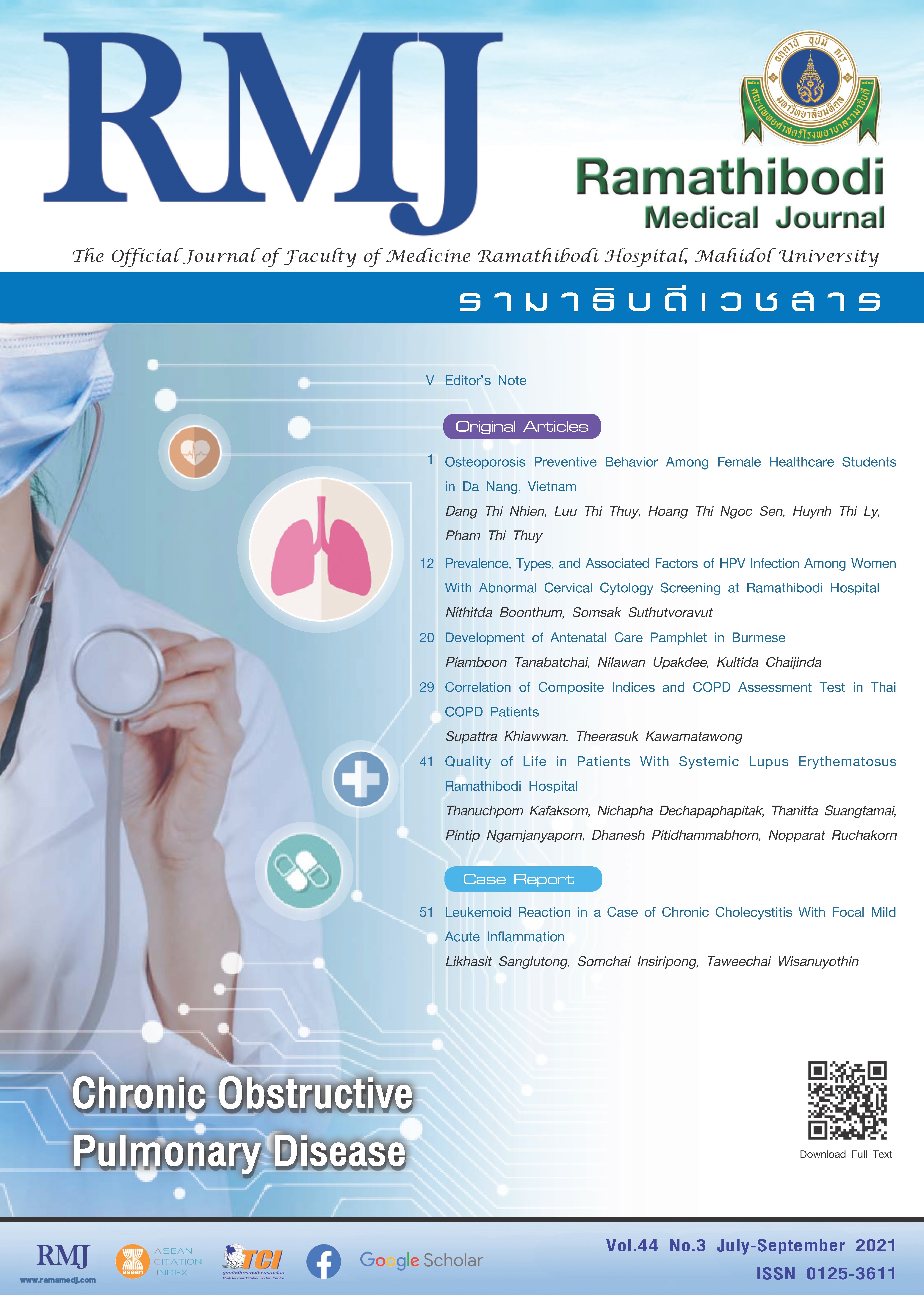Quality of Life in Patients With Systemic Lupus Erythematosus Ramathibodi Hospital
DOI:
https://doi.org/10.33165/rmj.2021.44.3.245850Keywords:
Systemic lupus erythematosus, Quality of life, FactorsAbstract
Background: Systemic Lupus Erythematosus (SLE) is an autoimmune disease. It is a chronic disease and exhibits symptoms in many organs and patients will be offered a variety of immunosuppressants, which may cause many side effects and worsen the quality of life.
Objective: To study the quality of life in SLE patients receiving treatment in Ramathibodi Hospital.
Methods: A cross-sectional study of all SLE patients were collected during February 2017 to February 2018, by using questionnaires to measure the quality of life.
Results: Total of 510 SLE patients, 96.7% were female. The mean (SD) age was 40.9 (13.0) years, and the disease duration was 10.5 (8.2) years. Most of them got a bachelor’s degree or higher (54.1%). Universal coverage scheme was the most treatment welfare of the patients. Despite the disease limitation for pregnancy, 7.2% of the SLE patients had 3 children while only 17.0% had miscarriages while pregnant. The general quality of life (SF-36) was in a good level, and disease-specific quality of life (SLEQoL) was at a moderate level. The older patients and a longer disease duration were inversely related to quality of life including physical health, overall health.
Conclusions: SLE patients who received the treatment at Ramathibodi Hospital had a relatively good quality of life. Factors related to quality of life were age and duration of the disease.
References
Tsang-A-Sjoe MWP, Bultink IEM, Heslinga M, van Tuyl LH, van Vollenhoven RF, Voskuyl AE. The relationship between remission and health-related quality of life in a cohort of SLE patients. Rheumatology (Oxford). 2019;58(4):628-635. doi:10.1093/rheumatology/key349
Stroie AM, Penescu MN, Petre N, Beldea G. Particularities of the evolution and therapeutic response in men with systemic lupus erythematosus and lupus nephritis. Internal Medicine. 2019;16(6):7-17. doi:10.2478/inmed-2019-0089
Danchenko N, Satia JA, Anthony MS. Epidemiology of systemic lupus erythematosus: a comparison of worldwide disease burden. Lupus. 2006;15(5):308-318. doi:10.1191/0961203306lu2305xx
Washio M, Kiyohara C, Ohta A. Epidemiology of Systemic Lupus Erythematosus. In: Lionaki S, ed. Lupus: New Advances and Challenges. IntechOpen; 2019:7-24. doi:10.5772/intechopen.84146
Mohamed A, Chen Y, Wu H, Liao J, Cheng B, Lu Q. Therapeutic advances in the treatment of SLE. Int Immunopharmacol. 2019;72:218-223. doi:10.1016/j.intimp.2019.03.010
Sokolova CR, Gamboa Cárdenas RV, Medina M, et al. SAT0581 Poor health-related quality of life (HRQoL) and fatigue are associated with a higher work productivity impairment in systemic lupus erythematosus (SLE) patients. Annals of the Rheumatic Diseases. 2019;78:1383. doi:10.1136/annrheumdis-2019-eular.6564
Leurmarnkul W, Meetam P. Properties testing of the retranslated SF-36 (Thai Version). Thai J Pharm Sci. 2005;29(1-2):69-88. Accessed May 5, 2021. http://www.thaiscience.info/journals/Article/TJPS/10471193.pdf
Kasitanon N, Wangkaew S, Puntana S, et al. The reliability, validity and responsiveness of the Thai version of systemic lupus erythematosus quality of life (SLEQOL-TH) instrument. Lupus. 2013;22(3):289-296. doi:10.1177/0961203312474702
Stojan G, Petri M. Epidemiology of systemic lupus erythematosus: an update. Curr Opin Rheumatol. 2018;30(2):144-150. doi:10.1097/BOR.0000000000000480
Davis-Porada J, Kim MY, Guerra MM, et al. Low frequency of flares during pregnancy and post-partum in stable lupus patients. Arthritis Res Ther. 2020;22(1):52. doi:10.1186/s13075-020-2139-9
Rivest C, Lew RA, Welsing PM, et al. Association between clinical factors, socioeconomic status, and organ damage in recent onset systemic lupus erythematosus. J Rheumatol. 2000;27(3):680-684.
Chaigne B, Chizzolini C, Perneger T, et al. Impact of disease activity on health-related quality of life in systemic lupus erythematosus - a cross-sectional analysis of the Swiss Systemic Lupus Erythematosus Cohort Study (SSCS). BMC Immunol. 2017;18(1):17. doi:10.1186/s12865-017-0200-5
Wandner LD, Scipio CD, Hirsh AT, Torres CA, Robinson ME. The perception of pain in others: how gender, race, and age influence pain expectations. J Pain. 2012;13(3):220-227. doi:10.1016/j.jpain.2011.10.014
Jung JY, Suh CH. Infection in systemic lupus erythematosus, similarities, and differences with lupus flare. Korean J Intern Med. 2017;32(3):429-438. doi:10.3904/kjim.2016.234

















